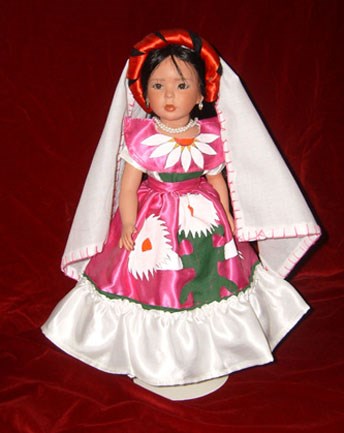
Capital: La Paz The dramatically colorful cactus and pitaya flower form the centerpiece of this costume. The yellow-gold pitaya adorns the center of the blouse and the bold green cactus fills the red apron above the cool white ruffled hemline. Just as this state's burning cacti-studded deserts meet miles of white coastline, this dress reflects the dramatic contrasts of the peninsula. Baja California Sur is the southern part of the peninsula of Baja California. A peninsula is a land area almost completely surrounded by water. Bordered by the Pacific Ocean to the west and the Gulf of California to the east, it has the most islands and the longest coastline, more than 1,200 miles, of any Mexican state. The sierras of San Francisco (where the Tres Vírgenes volcano is located), Guadalupe, and La Giganta form an almost continuous mountain range close to the coastline of the Gulf of California. Two coastal lagoons in the north of the state, the Ojo de Liebre and San Ignacio, are federally protected breeding grounds for the grey whale. Almost half-a-million tourists visit the sunny beaches of Baja California Sur annually. Fishing, salt extraction, agriculture, livestock, and the mining and production of plaster and phosphorite are all vital parts of the economy. The indigenous people of Baja California Sur include the Pericues in the south, the Guaycuras in the central area, and the Cochimies in the north. Did you know...? Other sources say that term stems from the Latin words calida fornax meaning "hot oven" and refer to the area's tremendously hot climate. Gradually, the name was modified and the peninsula became known as Antigua California (Old California), and later, Baja (lower) California. 
Capital: La Paz El principal atractivo de este traje es el colorido cactus y la flor de pitaya. La blusa está adornada con una pitaya de color amarillo, la falda blanca plisada lleva encima un delantal rojo con un cactus verde al centro, reflejando los dramáticos contrastes de la península. Baja California Sur ocupa la parte inferior de la península de Baja California. Una península es un área de tierra rodeada casi completamente por agua. Limita al oeste por el Océano Pacífico y al este por el Golfo de California, posee la mayoría de las islas y tiene la costa más larga de la republica Mexicana, con más de 2,000 kilómetros. Cerca de la costa del Golfo de California corre una cadena montañosa formada por las sierras de San Francisco (donde se localiza el volcán Tres Vírgenes), Guadalupe y La Giganta. En el norte del estado existen dos lagunas costeras: Ojo de Liebre y San Ignacio, lugares protegidos federalmente en donde se cría la ballena gris. Casi medio millón de turistas visitan las soleadas playas de Baja California Sur cada año. La pesca, la extracción de sal, la agricultura, la ganadería, la minería, la producción de yeso y fosforita son partes vitales de la economía. Los grupos indígenas de Baja California Sur son: los Pericúes en el sur, los Guaycuras en el centro y los Cochimies en el norte. Sabías que... Otras fuentes dicen que la palabra tiene su origen en el término latín calida fornax que significa "horno caliente" y se refiere al clima extremadamente caliente del área. Gradualmente, el nombre fue modifico y la península se conoció como Antigua California y más tarde, Baja California. |
Last updated: February 24, 2015
